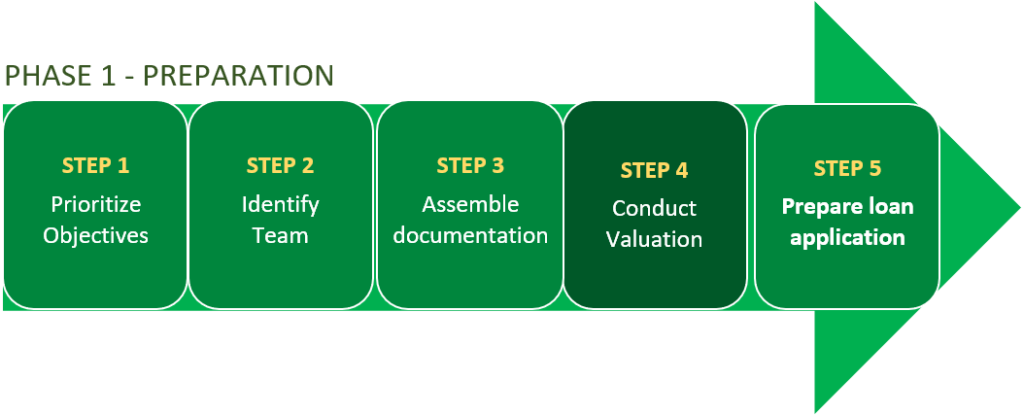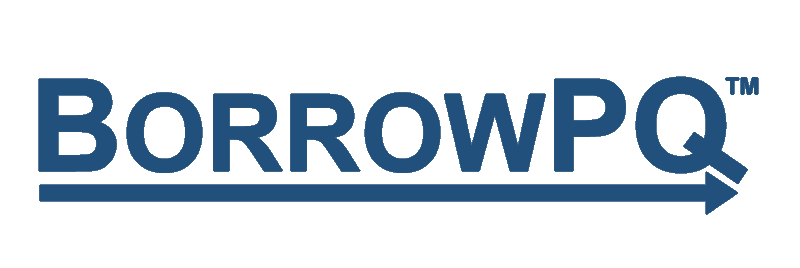
Conduct an Asset Valuation
BorrowPQ helps you estimate your borrowing base by taking an inventory of your business assets and evaluating them using standard practices to match up with lender criteria.
BorrowPQ produces estimated borrowing base valuations of your company’s core assets, including:
In the near future, BorrowPQ will be providing direct integration with popular business accounting packages. Until then, please enter the values requested in the following steps to produce a summary report of your business’s borrowing base.
Enter Income & Expense, Assets & Liabilities, and Debt Schedule Summary Information
Follow the Wizard steps and pull information from your financial records to complete the requested information. This information also feeds key elements of the Asset Valuation that follows.
Conduct Accounts Receivable Valuation
To estimate your A/R borrowing base value (how much you can realistically expect to borrow), enter your receivables by customer, sub-totaled by age.
The first step is to determine your A/R “availability”, or the total amount of receivables likely to be considered eligible as collateral by prospective lenders. This first excludes any A/R that is already over 90 days past due.
The next step is to identify and subtract other items that will be considered ineligible, or which lenders will consider an offset to the total booked value of your A/R. These deductions include:
- Offsetting Accounts Payable: A/R that is offset by A/P; i.e., for every dollar you owe a vendor who is also a customer, subtract one dollar from your A/R availability.
- Cross-Aged Receivables: A/R that is owed by a customer who has more than 50% of their amounts due aged over 90 days. Total and subtract the customer’s current A/R from your A/R availability.
- Concentration Surplus: Where a current customer represents more than 25% of your total receivables, calculate and subtract the amount that is greater than 25% from your A/R availability.
- Ineligibles – subtract the following from your A/R availability, if it exists:
- Uninsured foreign accounts (i.e., without credit insurance)
- Federal government accounts that are subject to Assignment of Claims Act
- Unearned receivables; e.g. from contracts where payments are subject to non-time-based criteria, such as advances, retainers, and holdback billings, or program percent complete billings.
- Account quality / weak customers. To make your estimate realistic, you may also want to identify and deduct weak customers from your A/R availability. This may be very subjective, but also important not to include collateral that increases the risk of default on your borrowing.
Your A/R Availability is the sum of your total A/R, minus accounts that are more than 90 days past due, minus offsets and ineligibles. Track the assumptions you’ve made about your adjustments for offsets and ineligibles in the comments / notes field in the calculator.
Finally, multiply your A/R Availability by the Advance Rate to determine your A/R Borrowing Base. The advance rate for A/R is typically 85%, but which your prospective lenders will set by taking your A/R “Dilution” into account, as follows:
Dilution is the difference between cash receipts and the booked value of your accounts, over time. This difference occurs for many reasons: for example, you may offer discounts or allowances, there may be offsetting warranty claims or returns, and you will have a certain amount of loss on the credit you extend.
Generally, the Advance Rate is calculated taking dilution into account using the formula: Advance Rate = 100% minus 2X Dilution plus 5%. Thus, a typical borrower with 5% dilution may be offered an Advance Rate of 100% minus (2 times 5%) plus 5%, or 100% minus 15%, or 85%. In this way Dilution of less than 5% commonly translates into an advance rate of 85% or higher assuming the lender finds the account quality and diversity to be otherwise acceptable. Naturally, borrowers with greater dilution will have a correspondingly lower Advance Rate.
Conduct Inventory Valuation
There are two principal models provided in BorrowPQ for estimating your inventory Borrowing Base (how much you can realistically expect to borrow using inventory as collateral):
- Book Value method: Estimating your Inventory Availability based on book value minus exclusions and ineligibles and applying an Advance Rate
- NOLV method: Determining an estimated NOLV (Net Orderly Liquidation Value), which may include typically a valuation via 3rd party liquidation specialists, and applying a NOLV Advance Rate
In both cases the BorrowPQ estimates are useful for lender screening and negotiation of terms, but as with all ABL, the final borrowing base certificate will be subject to an actual appraisal, which will produce a NOLV that for inventory is the final arbiter of value, as it is governed by the lender’s ability to take title to and liquidate the inventory in the event of default.
To get started, enter a summary of your inventory description and values by Vendor or Item type.
Book Value Method
This method takes your inventory book value and subtracts items that lenders consider ineligible or which will be treated as an offset to the value of the inventory, to determine inventory “availability”, or the total amount of inventory value that is likely to be considered eligible to be used as collateral by your prospective lender.
Once you have your total inventory value, the next step is to identify and subtract ineligible and offsetting items. These deductions will vary by lender and include subjective preferences often aligned with the lender’s industry focus, but generally include:
- WIP (Work In Progress) and obsolete stock: There are four main categories of inventory: raw materials, work-in-process (WIP), finished goods, and obsolete, or aged stock (held longer than 1 year)
- Itemize and subtract the value of WIP inventory
- Itemize and subtract the value of any stock that is obsolete or has been held over 1 year.
- Liquidation risk categories – types of inventory that lenders avoid due to risky liquidation profile, which are not necessarily ineligible, but will likely at least reduce the valuation
- Subject to spoiling / expiration (e.g., produce)
- High piece count / complex assembly requirements
- Offsite / in storage (unless waiver to access premises is provided to lender)
- A/R Availability Cap – depending on the borrower’s inventory turn-over rate, lenders will typically cap inventory availability on a multiple of accounts receivable. In this way lenders are using the borrower’s turn-over as a measure of the market’s appetite for the borrower’s goods. Typically, lenders cap inventory availability at 1.5 to 3 times A/R Availability
- Excess Inventory – depending on lender and marketability inventory, lenders may also reduce the inventory availability calculation by looking at excess inventory. Typically, this caps inventory availability for the primary advance rate at last year’s Gross Revenue (i.e., what the borrower can conservatively be expected to sell in the next year). Rather than making the excess inventory an exclusion, however, borrowers can expect to have the excess be subject to a lower advance rate.
Inventory Availability under this method is the sum of your Inventory current market value, minus offsets and ineligibles. Track the assumptions you’ve made about your adjustments for offsets and ineligibles in the comments / notes field in the calculator.
Finally, BorrowPQ multiplies your Inventory Availability by the Advance Rate to determine your Inventory Borrowing Base. The advance rate for Inventory in this method is typically 50%, with the result capped by A/R Availability as described above.
NOLV Method
This method takes your inventory book value and applies a NOLV rate (typically, 50%) to determine the NOLV inventory availability, and then applies a NOLV advance rate (typically, 85%) to determine your NOLV borrowing base, with a cap of, typically, 65% of total inventory value.
The cap can be hit if the NOLV rate and resulting inventory availability is more than 65% of inventory value. This circumstance happens most often when a borrower has a current independent appraisal of the inventory that shows a high liquidation value.
Thus, the formula for this method is simple: Inventory value times NOLV rate times Advance Rate, with a cap at a percentage of total inventory value.
Usually, the NOLV method produces a lower borrowing base value than the book value method, and is the starting point for borrowing base offers in lender letters of interest.
Conduct Machinery and Equipment Valuation
To estimate your M&E borrowing base value (how much you can realistically expect to borrow), enter your current machinery and equipment by item or vendor.
Your M&E “availability”, or the total value that is likely to be considered eligible as collateral by your prospective lender, is a simple formula determined by its NOLV (liquidation value). If you have a recent appraisal you should use that to set the NOLV rate, otherwise lenders typically assign 50%.
Track any assumptions you made about your M&E value in the comments / notes field in the calculator.
BorrowPQ multiplies your M&E Availability by the Advance Rate to determine your estimated M&E Borrowing Base. The advance rate for M&E is typically 75%, again subject to lender criteria and any current appraisal you may have in hand.
Track any assumptions you made about your M&E value in the comments / notes field in the calculator.
Conduct Real Estate Asset Valuation
To estimate your Commercial Real Estate (CRE) borrowing base value (how much you can realistically expect to borrow), complete the schedule of Real Estate Owned (REO).
Your CRE “availability”, or the total value that is likely to be considered eligible as collateral by your prospective lender, is a simple formula determined by the lender’s advance rate. Typically, asset-based lending for CRE takes the form of a mortgage and often provides term loan structure.
The BorrowPQ schedule of REO provides for you to list Owner Occupied (OO) as well as non-owner occupied (aka Investment Property). While ABL lenders typically will not include investment property as collateral in determining your CRE borrowing base, we recommend you include investment property owned in order to present the full picture of your cash-flow. Track any assumptions you’ve made about your M&E value in the comments / notes field in the calculator.
BorrowPQ multiplies your CRE Availability by the Advance Rate to determine your estimated CRE Borrowing Base. The advance rate for CRE is typically 75%, again subject to lender criteria and any current appraisals or other considerations you may have in hand.
Track any assumptions you’ve made about your M&E value in the comments / notes field in the calculator.
PQ can refer you to third-party advisors for this step including CPAs, CVAs, Commercial Mortgage Brokers, Tax Consultants, Lawyers, Accountants and more.
Contact Us at any time for help or to provide feedback

